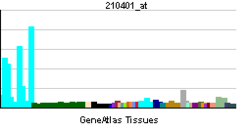- P2RX1
-
P2X purinoceptor 1 is a protein that in humans is encoded by the P2RX1 gene.[1]
The product of this gene belongs to the family of purinoceptors for ATP. This receptor functions as a ligand-gated ion channel with relatively high calcium permeability. Expressed in smooth muscle and platelets. Binding to ATP mediates synaptic transmission between neurons and from neurons to smooth muscle, being responsible, for example, for sympathetic vasoconstriction in small arteries, arterioles and vas deferens. Mouse studies suggest that this receptor is essential for normal male reproductive function. It is possible that the development of selective antagonists for this receptor may provide an effective non-hormonal male contraceptive pill.[2]
Contents
See also
References
- ^ Valera S, Talabot F, Evans RJ, Gos A, Antonarakis SE, Morris MA, Buell GN (Nov 1996). "Characterization and chromosomal localization of a human P2X receptor from the urinary bladder". Receptors Channels 3 (4): 283–9. PMID 8834001.
- ^ "Entrez Gene: P2RX1 purinergic receptor P2X, ligand-gated ion channel, 1". http://www.ncbi.nlm.nih.gov/sites/entrez?Db=gene&Cmd=ShowDetailView&TermToSearch=5023.
Further reading
- North RA (2002). "Molecular physiology of P2X receptors.". Physiol. Rev. 82 (4): 1013–67. doi:10.1152/physrev.00015.2002. PMID 12270951.
- Longhurst PA, Schwegel T, Folander K, Swanson R (1996). "The human P2x1 receptor: molecular cloning, tissue distribution, and localization to chromosome 17.". Biochim. Biophys. Acta 1308 (3): 185–8. PMID 8809107.
- Clifford EE, Parker K, Humphreys BD, et al. (1998). "The P2X1 receptor, an adenosine triphosphate-gated cation channel, is expressed in human platelets but not in human blood leukocytes.". Blood 91 (9): 3172–81. PMID 9558372.
- Sun B, Li J, Okahara K, Kambayashi J (1998). "P2X1 purinoceptor in human platelets. Molecular cloning and functional characterization after heterologous expression.". J. Biol. Chem. 273 (19): 11544–7. doi:10.1074/jbc.273.19.11544. PMID 9565569.
- Mulryan K, Gitterman DP, Lewis CJ, et al. (2000). "Reduced vas deferens contraction and male infertility in mice lacking P2X1 receptors.". Nature 403 (6765): 86–9. doi:10.1038/47495. PMID 10638758.
- Oury C, Toth-Zsamboki E, Van Geet C, et al. (2000). "A natural dominant negative P2X1 receptor due to deletion of a single amino acid residue.". J. Biol. Chem. 275 (30): 22611–4. doi:10.1074/jbc.C000305200. PMID 10816552.
- Dhulipala PD, Lianos EA, Kotlikoff MI (2001). "Regulation of human P2X1 promoter activity by beta helix-loop-helix factors in smooth muscle cells.". Gene 269 (1–2): 167–75. doi:10.1016/S0378-1119(01)00442-5. PMID 11376948.
- Ennion SJ, Evans RJ (2002). "Conserved cysteine residues in the extracellular loop of the human P2X(1) receptor form disulfide bonds and are involved in receptor trafficking to the cell surface". Mol. Pharmacol. 61 (2): 303–11. doi:10.1124/mol.61.2.303. PMID 11809854.
- Vial C, Rolf MG, Mahaut-Smith MP, Evans RJ (2002). "A study of P2X1 receptor function in murine megakaryocytes and human platelets reveals synergy with P2Y receptors". Br. J. Pharmacol. 135 (2): 363–72. doi:10.1038/sj.bjp.0704486. PMC 1573149. PMID 11815371. http://www.pubmedcentral.nih.gov/articlerender.fcgi?tool=pmcentrez&artid=1573149.
- Oury C, Toth-Zsamboki E, Thys C, et al. (2003). "The ATP-gated P2X1 ion channel acts as a positive regulator of platelet responses to collagen". Thromb. Haemost. 86 (5): 1264–71. PMID 11816716.
- Toth-Zsamboki E, Oury C, Watanabe H, et al. (2002). "The intracellular tyrosine residues of the ATP-gated P2X(1) ion channel are essential for its function". FEBS Lett. 524 (1–3): 15–9. doi:10.1016/S0014-5793(02)02987-3. PMID 12135734.
- Oury C, Toth-Zsamboki E, Vermylen J, Hoylaerts MF (2002). "P2X(1)-mediated activation of extracellular signal-regulated kinase 2 contributes to platelet secretion and aggregation induced by collagen". Blood 100 (7): 2499–505. doi:10.1182/blood-2002-03-0812. PMID 12239162.
- Rolf MG, Mahaut-Smith MP (2003). "Effects of enhanced P2X1 receptor Ca2+ influx on functional responses in human platelets". Thromb. Haemost. 88 (3): 495–502. doi:10.1267/THRO88030495. PMID 12353081.
- Strausberg RL, Feingold EA, Grouse LH, et al. (2003). "Generation and initial analysis of more than 15,000 full-length human and mouse cDNA sequences". Proc. Natl. Acad. Sci. U.S.A. 99 (26): 16899–903. doi:10.1073/pnas.242603899. PMC 139241. PMID 12477932. http://www.pubmedcentral.nih.gov/articlerender.fcgi?tool=pmcentrez&artid=139241.
- Valdecantos P, Briones R, Moya P, et al. (2003). "Pharmacological identification of P2X1, P2X4 and P2X7 nucleotide receptors in the smooth muscles of human umbilical cord and chorionic blood vessels". Placenta 24 (1): 17–26. doi:10.1053/plac.2002.0862. PMID 12495655.
- Oury C, Kuijpers MJ, Toth-Zsamboki E, et al. (2003). "Overexpression of the platelet P2X1 ion channel in transgenic mice generates a novel prothrombotic phenotype". Blood 101 (10): 3969–76. doi:10.1182/blood-2002-10-3215. PMID 12521992.
- Wang L, Andersson M, Karlsson L, et al. (2004). "Increased mitogenic and decreased contractile P2 receptors in smooth muscle cells by shear stress in human vessels with intact endothelium". Arterioscler. Thromb. Vasc. Biol. 23 (8): 1370–6. doi:10.1161/01.ATV.0000080350.37408.5A. PMID 12791671.
- Vial C, Pitt SJ, Roberts J, et al. (2004). "Lack of evidence for functional ADP-activated human P2X1 receptors supports a role for ATP during hemostasis and thrombosis". Blood 102 (10): 3646–51. doi:10.1182/blood-2003-06-1963. PMID 12907444.
External links
Ionotropic glutamates
ATP-gated channelsLigand-gated onlyVoltage- and ligand-gated‘Orphan’
B trdu: iter (nrpl/grfl/cytl/horl), csrc (lgic, enzr, gprc, igsr, intg, nrpr/grfr/cytr), itra (adap, gbpr, mapk), calc, lipd; path (hedp, wntp, tgfp+mapp, notp, jakp, fsap, hipp, tlrp)Categories:- Human proteins
- Membrane protein stubs
- Ion channels
Wikimedia Foundation. 2010.

